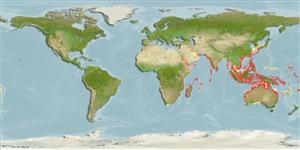Common names from other countries
Environment: milieu / climate zone / depth range / distribution range
экология
морской; солоноватоводный ассоциированный с рифами; пределы глубины 1 - 50 m (Ref. 90102). Tropical
Indo-Pacific: Red Sea (Ref. 33390) and East Africa to Papua New Guinea (Ref. 9710), north to southern Japan, south to Australia.
Size / Вес / Возраст
Maturity: Lm ? range ? - ? cm
Max length : 300 cm TL самец/пол неопределен; (Ref. 9710)
колючие лучи спинного плавника (общее число) : 0; членистые (мягкие) лучи спинного плавника (общее число) : 0; колючие лучи анального плавника: 0; членистые (мягкие) лучи анального плавника: 0; позвонки: 138 - 144. Basically white with black blotches and interspaces forming a honeycomb pattern (Ref. 30404, 48635). Some individuals have a near black overall appearance (Ref. 48635). Blotches variable between individuals and size, often in relation to habitat - those in clear coral reefs usually have proportionally less black than those found in turbid waters (Ref. 30404).
Inhabits reef flats and outer reef slopes of continental reefs (Ref. 9710). One of the two largest of Indo-Pacific morays. Often in holes with cleaner wrasses or shrimps (Ref. 48635). Feeds on cephalopods and small fishes (Ref. 30573). Large adults may be aggressive (Ref. 9710). Minimum depth reported taken from Ref. 30573.
Life cycle and mating behavior
Maturities | размножение | Spawnings | Egg(s) | Fecundities | личинки
Chen, H.-M., K.-T. Shao and C.T. Chen, 1994. A review of the muraenid eels (Family Muraenidae) from Taiwan with descriptions of twelve new records. Zool. Stud. 33(1):44-64. (Ref. 6934)
Статус Красного Списка МСОП (Ref. 130435)
CITES (Ref. 128078)
Not Evaluated
Угроза для людей
Reports of ciguatera poisoning (Ref. 4537)
Использование человеком
рыболовство: не имеет хозяйственного значения; аквариум: общественные аквариумы
дополнительная информация
инструменты
Специальные отчеты
Скачать в формате XML
ресурсы в Интернет
Estimates based on models
Preferred temperature (Ref.
115969): 24.5 - 29.1, mean 28.1 (based on 1258 cells).
Phylogenetic diversity index (Ref.
82804): PD
50 = 0.5000 [Uniqueness, from 0.5 = low to 2.0 = high].
Bayesian length-weight: a=0.00035 (0.00021 - 0.00058), b=3.27 (3.13 - 3.41), in cm Total Length, based on LWR estimates for this species & Genus-body shape (Ref.
93245).
Trophic level (Ref.
69278): 4.4 ±0.51 se; based on food items.
устойчивость к внешним воздействиям (Ref.
120179): очень низкий, минимальное время удвоения популяции более 14 лет (Preliminary K or Fecundity.).
Fishing Vulnerability (Ref.
59153): Very high vulnerability (90 of 100).
